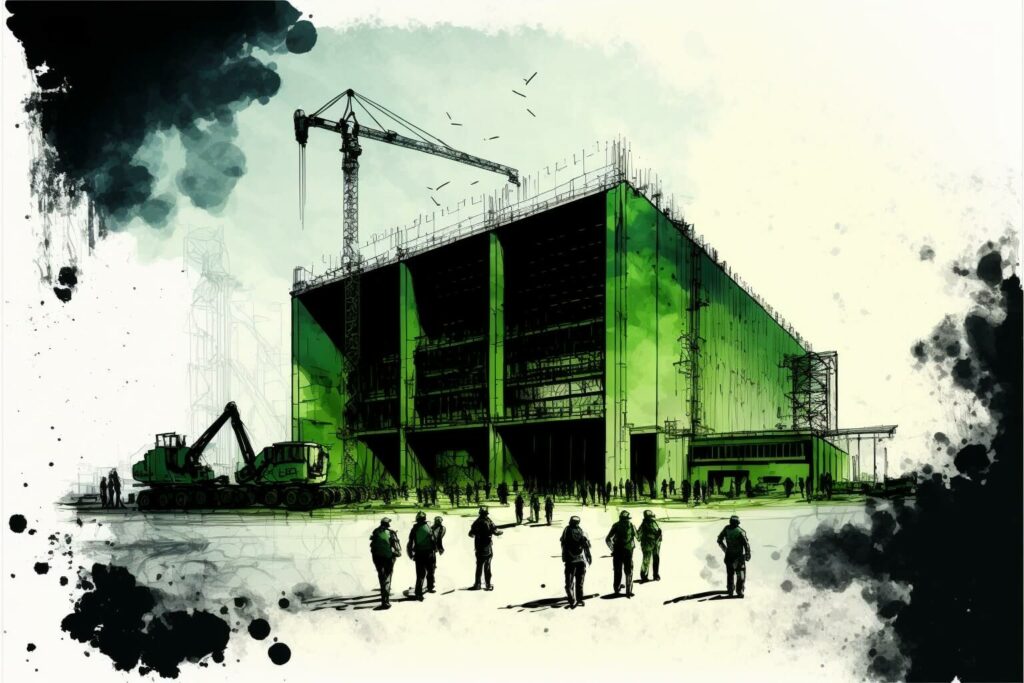




A 2-day immersion into the future of sustainable construction
The construction industry is at a crossroads: will we continue prioritizing profits over people and the planet, or will we embrace the growing demand for more sustainable and socially responsible projects?
ESG (environmental, social, and governance) principles offer a way forward, but what exactly do they mean, and how can construction companies integrate them into their practices? This thought-provoking article will delve into the world of ESG in construction and explore the benefits it can bring to businesses and society.
From reducing environmental impacts to improving employee relations and increasing transparency, the potential effects of ESG are far-reaching. Don’t miss this opportunity to learn more and position your construction company for success in the 21st century.
Join us on this journey to a more sustainable and ethical future.


What is the ESG in construction approach to the environment?
A company can manage its environmental impact during the construction process in a variety of ways, including:
- Implementing waste management plans: recycling or reusing materials whenever possible, properly disposing hazardous materials, and reducing waste generated during construction.
- Using energy-efficient equipment and practices: Using energy-efficient lighting and appliances, designing buildings with energy efficiency in mind, and implementing energy-saving measures during construction are some examples.
- Using sustainable materials: In construction projects, this could include using recycled materials, locally sourced materials, or materials with low environmental impact.
- Implementing water conservation measures: Some examples are using drought-resistant plants and efficient irrigation systems, installing low-flow fixtures, and reducing water usage during construction.
- Protecting natural habitats: This could include avoiding construction in sensitive areas, minimizing the impact of construction on local ecosystems, and putting in place measures to protect wildlife and natural habitats while the building is underway.
- Offsetting carbon emissions: This could include buying carbon credits or implementing measures to reduce carbon emissions during construction, such as using alternative transportation or renewable energy sources.
Companies must carefully consider the environmental impact of their construction projects and implement measures to minimize this impact to the greatest extent possible.
What is the ESG in construction approach to social?
A company can consider the social impact of its construction projects in a variety of ways, including:
- Ensuring fair and safe labor practices: This may include adhering to all applicable labor laws, providing safe working conditions, and providing workers with fair wages and benefits.
- Engaging with local communities: Consulting with residents and organizations, addressing any concerns they may have, and attempting to minimize the negative impact of construction on the community are examples.
- Creating accessible and inclusive spaces: This could include designing buildings that are accessible to people with disabilities, incorporating universal design principles, and taking into account the needs of a diverse range of users.
- Promoting diversity and inclusion could include putting diversity and inclusion initiatives in place in the workplace, such as hiring and nurturing a diverse workforce and ensuring that all workers are treated with respect and dignity.
- Giving back to the community could include donating to local charities and organizations, volunteering time and resources, and participating in community development projects.
Businesses must consider how their construction projects will affect society and take action to minimize any negative impacts and boost any beneficial contributions to the community.
What is the ESG in construction approach to governance?
The governance approach of a company refers to the systems and processes in place to ensure ethical behavior, transparency, and effective risk management.
Some examples of how a company can demonstrate a solid approach to governance in the construction industry are:
- Clear ethical guidelines could include developing an employee code of conduct, establishing procedures for reporting unethical behavior, and ensuring that all employees are trained in ethical practices.
- Being transparent in business practices could include disclosing information about the company’s operations and financial performance, communicating with stakeholders, and providing regular updates on company activities.
- Implementing effective risk management systems: Identifying and assessing potential risks, putting measures in place to mitigate those risks, and continuously monitoring and reviewing risk management processes are examples.
- Having strong internal controls: This could include putting in place systems for financial reporting and internal auditing, as well as putting in place solid corporate governance policies and ensuring that all employees are held accountable for their actions.
A construction company can increase stakeholder trust and lower the chance of corrupt activities or other undesirable events by displaying a solid approach to governance.


How can a construction company track and report on its ESG in construction performance, and how is this information made available to stakeholders?
There are several ways that a construction company can track and report on its ESG performance:
- Self-reporting: The business can produce reports on its environmental, social, and governance (ESG) performance detailing its actions to enhance these practices.
- Third-party certification: For its environmental performance, the company can seek accreditation from an independent organization such as LEED (Leadership in Energy and Environmental Design) or the Global Reporting Initiative (GRI).
- ESG ratings: The company’s ESG performance can be rated by an independent organization, such as Sustainalytics or MSCI.
- Disclosing information in financial reports: The company can include ESG performance information in its financial statements, such as its annual or sustainability reports.
The corporate website, press releases, media outreach, stakeholder meetings, and events are just a few ways this information can be shared with stakeholders. Therefore, it’s crucial for businesses to be open about their ESG performance and to provide stakeholders with simple access to this data.
Adverse impacts from the construction sector
- Pollution: Construction activities can produce a wide range of pollutants, including air pollution from construction equipment and materials and water pollution from construction materials and waste runoff.
- Natural habitat degradation: Construction projects can disrupt natural habitats by destroying or fragmenting natural areas, altering water flow, or introducing invasive species.
- Construction activities can generate noise and vibration, disrupting local communities and wildlife.
- Traffic congestion: Construction projects can cause traffic congestion and safety issues in the area.
- Community displacement: Some construction projects may involve the removal of local communities, either through eminent domain or the demolition of existing structures.
- Poor working conditions: Some construction companies may fail to provide safe and equitable working conditions for their employees, resulting in various negative consequences such as injury, illness, and exploitation.
The potential adverse effects of construction projects should be thoroughly addressed, and any efforts that can be taken to lessen these effects should be taken.








A 2-day immersion into the future of sustainable construction
Benefits of ESG in construction companies
- Improved reputation: Construction companies can improve their standing with stakeholders such as customers, employees, investors, and the general public by demonstrating a commitment to sustainability and social responsibility. Improved reputation can aid in the development of trust and long-term relationships.
- Increased efficiency: Using ESG practices can help construction companies run more efficiently and save money. Using energy-efficient equipment and techniques, for example, can reduce energy consumption and energy bills, while recycling and reusing materials can help reduce waste.
- Access to new markets: Some clients and investors may prefer companies with strong ESG performance, and implementing ESG practices can assist construction firms in accessing new markets and opportunities.
- Improved risk management: Construction companies can protect their reputation and financial performance by implementing effective risk management systems and strong internal controls.
- Positive impact on society: Construction companies can positively contribute to society and the environment by considering their projects’ social and environmental impact. Such practice can create a more sustainable and livable world for future generations.
What are the challenges involved in implementing ESG in construction?
Implementing ESG (environmental, social, and governance) practices in the construction industry can present several challenges:
- Cost: Implementing ESG practices may necessitate additional expenditures, such as purchasing energy-efficient equipment or sustainable materials. Purchasing expensive equipment can be challenging for some construction companies, particularly smaller firms with limited resources. Energy-efficient equipment might require higher capital expenditure, but they are usually cost-effective in the long term.
- Lack of knowledge and expertise: Some construction companies may need more knowledge to implement ESG practices effectively. This lack of expertise can be especially true for smaller businesses needing more dedicated sustainability experts or the resources to hire consultants.
- Resistance to change: Some employees or contractors may resist changes to established practices, especially if they involve additional costs or the acquisition of new skills.
- Lack of clear guidance: When implementing ESG practices in the construction industry, there may be a need for clear guidance or standards, making it difficult for businesses to know where to begin or how to measure their performance.
- Limited resources: Some construction companies may need more help, such as time or budget, which can make implementing ESG practices difficult. Companies can also decide to enforce ESG practices too late into the construction, which may bring higher costs than they would have if such practices were thought of at the very beginning of the project.
It is critical to recognize that each company’s situation is unique. The balance of benefits and challenges may vary depending on various factors, including the company’s size, resources, and industry.
Some businesses may find that the benefits of implementing ESG practices outweigh the challenges, whereas others may face more significant challenges that make justifying the investment more difficult.
Finally, the decision to implement ESG practices in the construction sector should be based on a thorough examination of the company’s specific circumstances and the potential benefits and challenges that may be encountered.


Case studies of ESG in Construction
Here are a few companies that have incorporated ESG (environmental, social, and governance) practices into their buildings:
Skanska: Skanska is a construction and development company that has implemented many environmental, social, and governance (ESG) initiatives in its buildings. For example, it has created many LEED-certified buildings that are energy-efficient and environmentally friendly. Skanska has also launched several initiatives to promote workplace diversity and inclusion, such as its Women in the Leadership program.
WELL Building Standard: The WELL Building Standard is a rating system that focuses on building occupants’ health and well-being. Salesforce, Deloitte, and Herman Miller are among the companies that have achieved WELL certification for their buildings. These buildings include various features that promote occupant health, such as air purification systems and access to natural light.
The Eden Project: The Eden Project is a sustainable development project in Cornwall, England, with several environmentally friendly buildings. The project includes a series of geodesic domes that house plants from all over the world, and the facilities are built with environmentally friendly materials and energy-efficient systems.
The Bullitt Center: The Bullitt Center is a six-story office building in Seattle, Washington, designed to be ultra-energy efficient and environmentally friendly. The building has LEED Platinum certification and includes several sustainability features, such as a rainwater collection system and a solar panel array.
These are just a few examples of businesses incorporating ESG practices into their buildings. There are numerous other examples of companies and organizations worldwide taking steps to create more sustainable and socially responsible structures.
ESG In Construction: Conclusion
In conclusion, because the construction sector significantly impacts society and the environment, businesses must include ESG (environmental, social, and governance) principles in their business operations.
As a result, construction businesses can produce more environmentally friendly and socially responsible projects by reducing their environmental impact, interacting with local people, and supporting moral and open business practices.
There are many ways that companies can track and report on their ESG performance, and they need to be transparent about their efforts and make this information easily accessible to stakeholders.
If you are interested in learning more about applying ESG principles in the construction industry, consider exploring our green building consultancies or our green building courses. These resources can provide valuable insights and guidance on creating more sustainable and socially responsible buildings.








A 2-day immersion into the future of sustainable construction
If you need our services in the Portuguese language, click here.

